This essay was originally published in The Public Domain Review under a Creative Commons License. Please see their rules for reuse.
In late 1726 much of Britain was caught up in the curious case of Mary Toft, a woman from Surrey who claimed that she had given birth to a litter of rabbits. Niki Russell tells of the events of an elaborate 18th century hoax which had King George I’s own court physicians fooled.
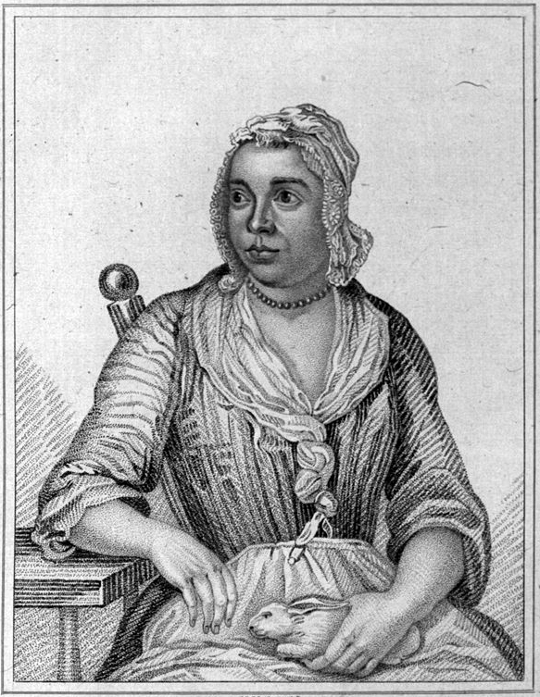
In September 1726, news reached the court of King George I of the alleged birth of several rabbits to Mary Toft (1703-1763) of Godalming, near Guildford, in Surrey. Mary was a twenty-five year old illiterate servant, married to Joshua Toft, a journeyman clothier. According to reports, despite having had a miscarriage just a month earlier in August 1726, Mary had still appeared to be pregnant. On September 27th, she went into labour and was attended initially by her neighbour Mary Gill, and then her mother in law Ann Toft. She gave birth to something resembling a liverless cat.
The family decided to call on the help of Guildford obstetrician John Howard. He visited Mary the next day where he was presented with more animal parts which Ann Toft said she had taken from Mary during the night. The following day, Howard returned and helped deliver yet more animal parts. Over the next month Howard recorded that she began producing a rabbit’s head, the legs of a cat and in a single day, nine dead baby rabbits.
Howard sent letters to some of England’s greatest doctors and scientists and the King’s secretary, informing them of the miraculous births. The curious King dispatched two men to investigate to see what they could ascertain about this case: Nathaniel St. André, Swiss surgeon-anatomist to the King, and Samuel Molyneux, secretary to the Prince of Wales.
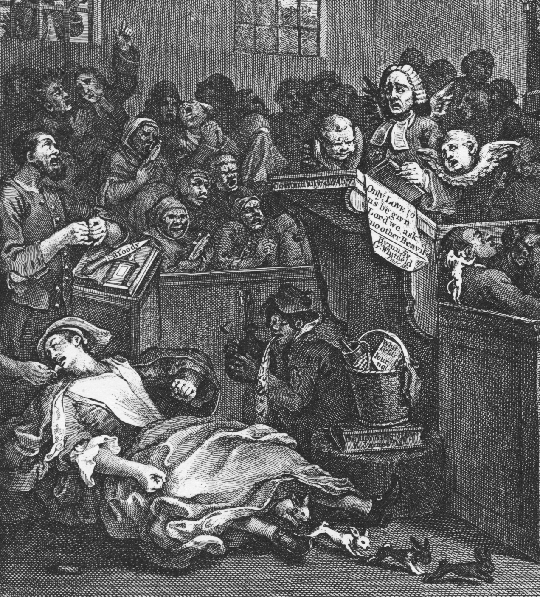
By now, news had spread and Mary was a local celebrity which necessitated moving her from Godalming to nearby Guildford so that she could be monitored more closely by John Howard. On November 15th St. André and Molyneux arrived at Howard’s home in Guildford and were immediately greeted with the news that Mary was in labour with her fifteenth rabbit. Toft gave birth to several more dead rabbits in their presence. The doctors conducted examinations on the lungs and other internal organs of these rabbits, the results of which showed that they probably did not develop inside Mary’s womb. St. André, however, still seemed convinced that her case was genuine. He believed that these were indeed supernatural births, and took some of the rabbit specimens back to London to show the King and the Prince of Wales.
As the story of Mary Toft quickly spread through London, the King decided to send a German surgeon, Cyriacus Ahlers, and his friend Mr. Brand to Guildford to investigate the matter further. Ahlers examined Mary and witnessed several of her rabbit births; however, he was not convinced. On examination of the rabbit parts he had taken back to London, Ahlers found that the dung pellets in the rectum of one of the rabbits contained corn, hay and straw, which proved that it could not have developed inside Mary. Ahlers reported back to the King on November 21st that he suspected a hoax with Mary Toft and John Howard in collusion and showed these rabbit specimens as evidence.
Meanwhile, Sir Richard Manningham (1690-1759) — an eminent doctor and midwife among upper class society in London — was contacted by St André to attend upon Mary Toft. After observing her and seeing her give birth to what he believed was a hog’s bladder, he also seemed unconvinced. But he was persuaded to keep his doubts to himself by Howard and St. André until there was proof of any fraud. It seems Howard and St. André were trying to save their reputations in the light of what Ahlers had concluded.
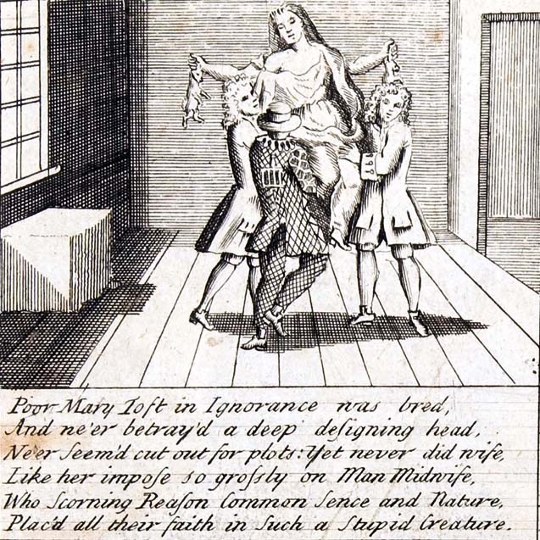
On November 29th, Mary Toft was brought to Lacy’s Bagnio (bath house) in London’s Leicester Fields, where she could be observed more closely. St André contacted Dr. James Douglas, the respected anatomist and man-midwife, and asked him to come to the bagnio to observe Mary’s rabbit births. By the time Douglas arrived, he found himself in the company of a large crowd of doctors and medical men who had been summoned by St. André. Unfortunately for St. André, who was desperate to have Douglas validate the rabbit births, Douglas believed the whole affair to be a fraud.
Between 30th November and 3rd December, opinion was divided among the medical men gathered there. Mary produced no more new rabbits, but continued to appear to go into labour. She was also badly infected and had fits which made her lose consciousness. Shortly thereafter, a porter at Mr. Lacy’s bagnio was caught trying to sneak a rabbit into Mary Toft’s room. He confessed to Douglas and Manningham that Margaret Toft (Mary’s sister-in-law) had asked him to procure the smallest rabbit he could find. Manningham and Douglas were determined to obtain a confession of guilt from Mary but decided to see if she would incriminate herself. They didn’t have long to wait as she went into labour on 4th December but produced nothing. On that evening they called Sir Thomas Clarges, Justice of the Peace, to the bagnio. The porter, Thomas Howard, swore a deposition before him and Clarges immediately took Mary into custody for questioning but she would admit nothing. Over the next two days, much pressure was put upon her to confess but Mary held out until Sir Richard Manningham threatened to perform painful experimental surgery on her to see if she was formed differently from other women. Toft was forced to admit on 7th December 1726 that she had manually inserted dead rabbits into her vagina and then allowed them to be removed as if she were giving birth. In several different confessions, she implicated a mysterious stranger, the wife of the organ grinder, her mother in law, and John Howard. On the 9th December, Mary Toft was charged with being a “Notorious and Vile Cheat” and sent to Bridewell prison where, allegedly, she was exhibited to large, curious crowds by her warders.
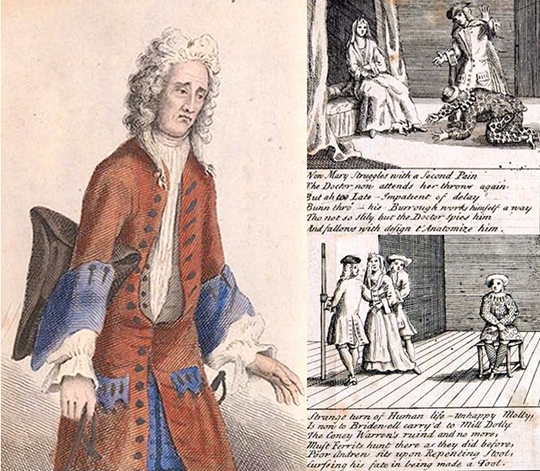
The timing of Toft’s confession proved extremely awkward for St. André, who only 4 days earlier, on the 3rd December, had published his forty-page pamphlet A Short Narrative of an Extraordinary Delivery of Rabbets, in which he gives a detailed, non-sceptical, account of events. In the pamphlet he describes Mary’s explanation of events: how, in April 1726, she had been working in a field and was startled by a rabbit. She, and another woman, ran after it, and but could not catch it. They also failed to catch another rabbit that they had chased. “That same Night she dreamt she was in a Field with those two Rabbets in her Lap, and awakened with a sick Fit, which lasted till Morning; from that time, for above three months, she had a constant and strong desire to eat Rabbets, but being very poor and indigent cou’d not procure any.”
If one assumes St Andre was not complicit in the hoax (though Ahler believed him to be) it was most likely this explanation of Toft’s which had him so convinced, tying in as it did so neatly with the theory of ‘maternal impression’, an idea popular at the time, which explained the existence of birth defects and congenital disorders. The theory proposed that an emotional stimulus experienced by a pregnant woman (such as Mary’s rabbit dreams and her desire for rabbit meat) could influence the development of the foetus. Mental problems, such as depression or schizophrenia were believed to be a manifestation of similar feelings in the mother. For instance, a woman who experienced great sadness whilst pregnant might imprint depressive tendencies onto the foetus she was carrying.
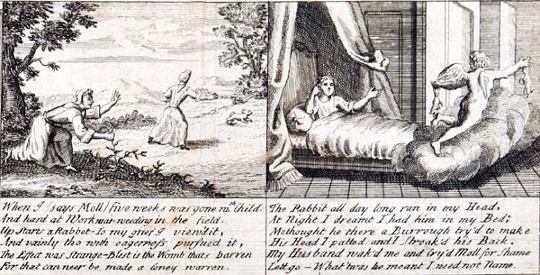
The case of Joseph Merrick (1862-1890), the so-called Elephant Man, is perhaps one of the most famous instances of the theory of “maternal impression” being applied. Merrick wrote in his autobiographical pamphlet “The deformity which I am now exhibiting was caused by my mother being frightened by an Elephant; my mother was going along the street when a procession of Animals was passing by, there was a terrible crush of people to see them, and unfortunately she was pushed under the Elephant’s feet, which frightened her very much; this occurring during a time of pregnancy was the cause of my deformity”. Five months after the Mary Toft affair was exposed as a hoax, James Blondel published his The Strength of Imagination in Pregnant Women Examin’d in which he challenged the belief in the prenatal influence of the imagination. The debate he started continued well into the next century.
Indeed, in the aftermath of the hoax, the medical profession suffered a great deal of mockery for what the public viewed as its gullibility. On December 9th, St. André had an advertisement (shown below) published in the Daily Journal to try and vindicate his own behaviour. Doctors responded to the Toft affair in print as many were concerned that the episode had damaged the reputation, not only of the doctors involved, but of the profession as a whole. One of the many tracts and pamphlets that appeared during the saga was The Anatomist Dissected by a certain Lemuel Gulliver, “Surgeon and Anatomist to the Kings of Lilliput and Blefescu, and Fellow of the Academy of Sciences in Balnibarbi” — a pseudonym of Jonathan Swift’s and allusion to his satire Gulliver’s Travels published in 1726.
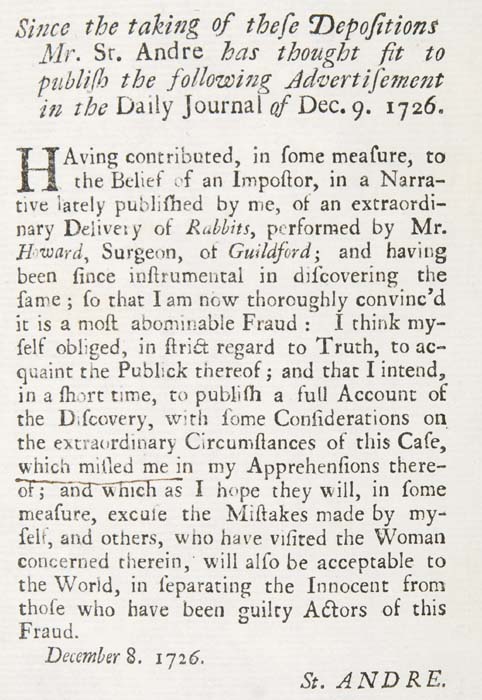
Part of the reason the Mary Toft case generated so much interest and discussion was the fact that, although babies had been traditionally delivered by female midwives, the rapidly growing field of medical science had recently begun to dominate the area of obstetrics among the upper classes. Men were being promoted as experts on the theory of reproduction, although they were often viewed with mistrust due to the access they had to women’s bodies. Female midwives were now being thought of by some as part of a superstitious past that had no place in the new scientific age. The fact that an illiterate woman like Mary Toft had fooled many eminent doctors, some with royal connections and patients, put the debate between science and the old traditions sharply in focus. Mary herself didn’t seem particularly impressed by at least one of the doctors who attended her — she called Dr Ahlers a ‘fumblefisted fellow as was never cut out to handle gentlewomen’.
The case also proved to be irresistible to contemporary artists. In the satirical print shown below, William Hogarth pokes fun at the incompetence of the early 1700s medical profession. All the main characters in the Toft saga are featured, the doctors being shown as ignorant and credulous fools. Many Britons were angry about the Hanoverian King’s preference for German speaking courtiers and physicians. This is amply demonstrated by the plethora of pamphlets and drawings that appeared in the wake of the Toft scandal, ridiculing St. André and the German court physicians and depicting them as gullible or, even worse, as charlatans. The Prince of Wales was singled out for a great deal of mockery too. Public interest in the case died out by around January of the following year, but the repercussions continued for those involved. For Sir Richard Manningham and James Douglas there had been temporary embarrassment regarding their close connection with the affair but their careers and reputations were secure.
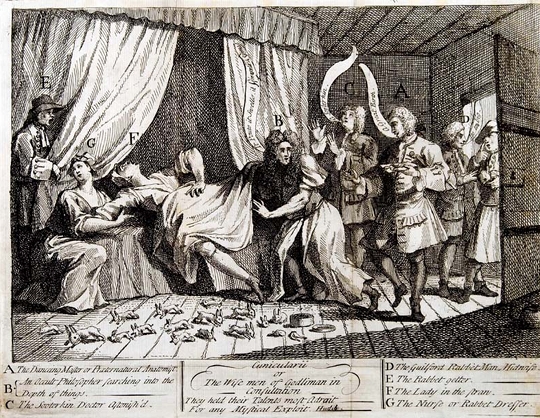
St André, however, lost favour with the court and, as his reputation plummeted, his patients deserted him. He retired from London and eventually died in poverty in an almshouse in Southampton. John Howard had to answer charges of being concerned in the ‘Cheat and Conspiracy of Mary Toft’ but the case against him was dropped and he remained a respected figure in Guildford.
As for Mary Toft, the case against her was dismissed, not for lack of proof of guilt, but probably because of the further embarrassment to the establishment that would ensue if the case were pursued any further. She spent a few months in jail then returned to relative obscurity. The question as to why she and her family went to such extraordinary lengths to convince the nation that Mary had the ability to give birth to rabbits is perhaps not too hard to answer. Monstrous or deformed people had been exhibited, at a price, all over Europe for hundreds of years, with poor and wealthy alike equally fascinated. Ironically for Mary, although the hoax was not successful, she did succeed for a while in becoming an object of curiosity. In the years that followed the scandal, the Duke of Richmond (who had a residence near Godalming) sometimes showed her at dinner parties for the curiosity of his guests. In April 1740 Mary was charged with receiving stolen goods and committed to the House of Correction in Guildford but was later acquitted by the jury. She died on 13th January 1763. The London papers’ obituary columns announced her death alongside those of peers and statesmen.
Niki Russell is Chief Library Assistant at Special Collections in
the University of Glasgow Library. She blogs on her work with rare books and manuscripts: see the Special Collections website.
This article is based on “The Curious Case of Mary Toft”, a Book of the Month feature from the University of Glasgow’s Special Collections Department — see their page for more pictures and scans of doucments relating to the case and for a wonderfully comprehensive list of related sources which exist in their Hunterian Collection.
A version of The Doctors in Labour; or a new Whim Wham from Guildford (1726) at Wikmedia Commons
A short narrative of an extraordinary delivery of rabbets, perform’d by Mr John Howard, Surgeon at Guilford (1727), by Nathaniel St. André.
The Female Physician (1724), by John Maubray
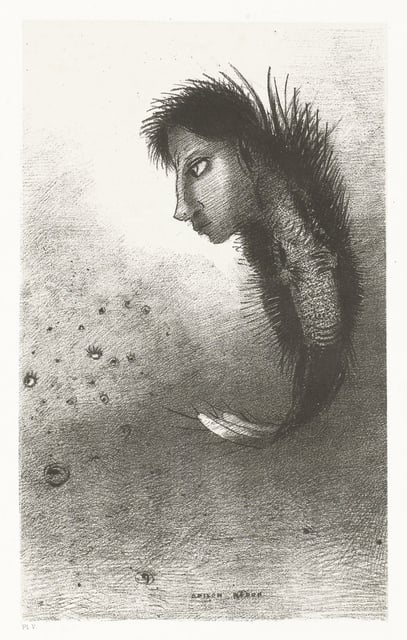 The Redemption of Saint Anthony
Joseph Banks: Portraits of a Placid Elephant
Patricia Fara traces the changing iconography of Joseph Banks, the English botanist who travelled on Captain Cook’s first great voyage and went on to become President of the Royal Society and important patron for a whole host of significant developments in the natural sciences.
The Redemption of Saint Anthony
Joseph Banks: Portraits of a Placid Elephant
Patricia Fara traces the changing iconography of Joseph Banks, the English botanist who travelled on Captain Cook’s first great voyage and went on to become President of the Royal Society and important patron for a whole host of significant developments in the natural sciences.